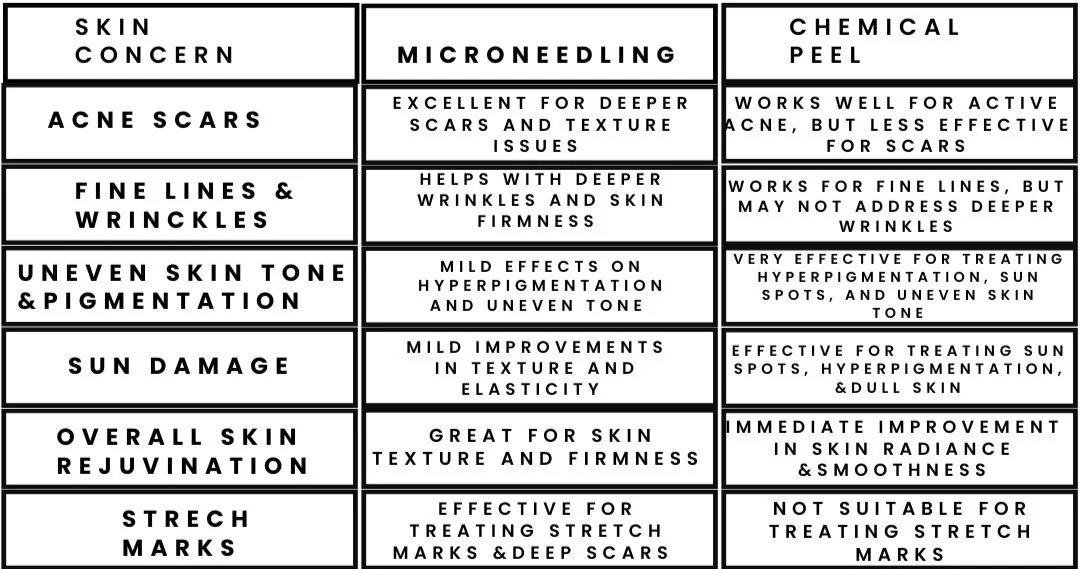Microneedling vs Chemical peel
When comparing microneedling vs. chemical peels, neither is definitively "better" than the other. Both treatments offer unique benefits, and the choice between the two depends on your specific skin concerns, goals, and preferences. Let's break down the advantages of each to help determine which might be best for you or your clients.
Microneedling: What is it and What Does it Do?
How it works: Microneedling, or collagen induction therapy, involves using tiny needles to create micro-injuries in the skin, stimulating the body's natural healing process and promoting the production of collagen and elastin. This treatment helps with deeper skin concerns like scarring, texture, and fine lines.
Best for:
Acne scars
Stretch marks
Fine lines and wrinkles
Uneven skin texture
Pore size reduction
Skin rejuvenation
Benefits:
Stimulates collagen production, which improves skin’s firmness and texture.
Targets deeper skin layers, making it effective for scars and stretch marks.
Minimal downtime compared to other treatments; clients may experience redness or mild swelling, but it typically fades in a few hours.
Can treat multiple concerns, including skin texture, tone, and firmness.
Drawbacks:
Gradual results: Microneedling requires a series of treatments (usually 3–6 sessions) for optimal results, and full effects may take several weeks to appear.
Not as effective for surface-level pigmentation as chemical peels.
Chemical Peels: What is it and What Does it Do?
How it works: A chemical peel involves applying a chemical solution (such as glycolic, salicylic, or lactic acid) to the skin, which exfoliates the surface layers and removes dead skin cells. Peels can range from superficial (mild exfoliation) to deep (targeting deeper layers of the skin) and are used to address issues like pigmentation, acne, and sun damage.
Best for:
Uneven skin tone and pigmentation (e.g., age spots, sun damage)
Dull or dry skin
Acne and acne-related issues (including clogged pores)
Fine lines and superficial wrinkles
Overall skin texture and brightness
Benefits:
Immediate results: After just one treatment, clients may notice brighter, smoother skin, with more noticeable improvements after a few treatments.
Can address surface-level concerns: Effective for treating sun damage, hyperpigmentation, and uneven skin tone.
Range of peel strengths: From superficial to deep peels, offering a customized treatment for different skin concerns.
Drawbacks:
Downtime: Depending on the strength of the peel, recovery time can vary from a few days to a week, with redness, peeling, and flaking.
May not be suitable for all skin types: For deeper peels, some individuals with sensitive skin or darker skin tones may experience more irritation or pigmentation changes.
Which Treatment is Better for You?
Here's a quick comparison based on your skin concerns!
Microneedling vs. Chemical Peel: Which Should You Choose?
Choose Microneedling If:
You have deeper skin concerns like acne scars, stretch marks, or large pores.
You want to stimulate collagen and improve skin texture over time.
You prefer minimal downtime (redness and swelling for a few hours).
You’re seeking long-term skin rejuvenation.
Choose Chemical Peels If:
You want to improve skin tone, reduce hyperpigmentation, or address sun damage.
You prefer immediate results (with mild to medium peels).
You have surface-level concerns, like acne, dry skin, or dullness.
You’re looking for a treatment that brightens and exfoliates your skin.
Combining Both Treatments
Some people choose to combine microneedling and chemical peels for optimal results. A peel can exfoliate the outer layers of the skin, making it more receptive to microneedling, which in turn stimulates deeper layers to promote collagen production. This combined approach can be ideal for people looking to address both surface and deeper skin concerns.
Conclusion: Which is Better?
There is no definitive answer as to whether microneedling or chemical peels are "better." It depends entirely on your skin’s needs. Microneedling is great for texture issues, scarring, and collagen stimulation, while chemical peels are fantastic for treating uneven skin tone, pigmentation, and giving your skin a quick glow. Both can be effective, and combining them might give you the best of both worlds.

